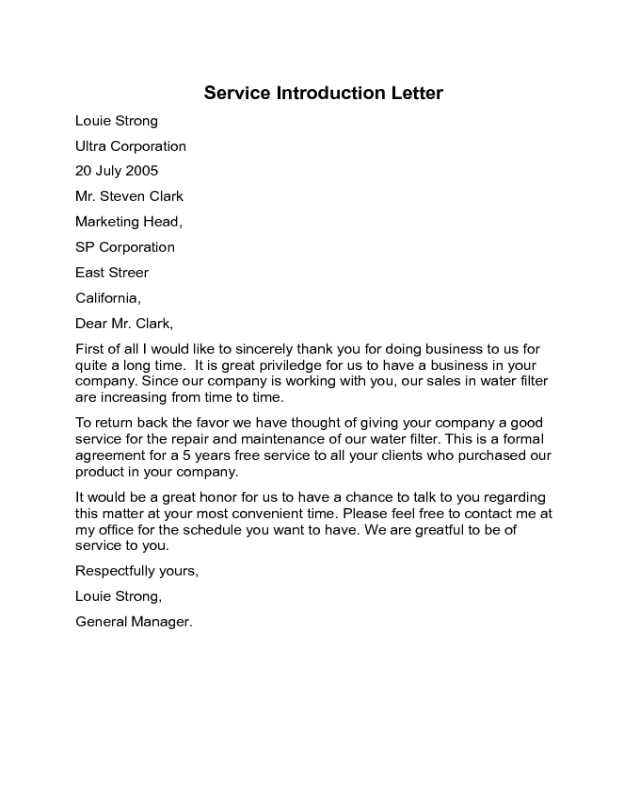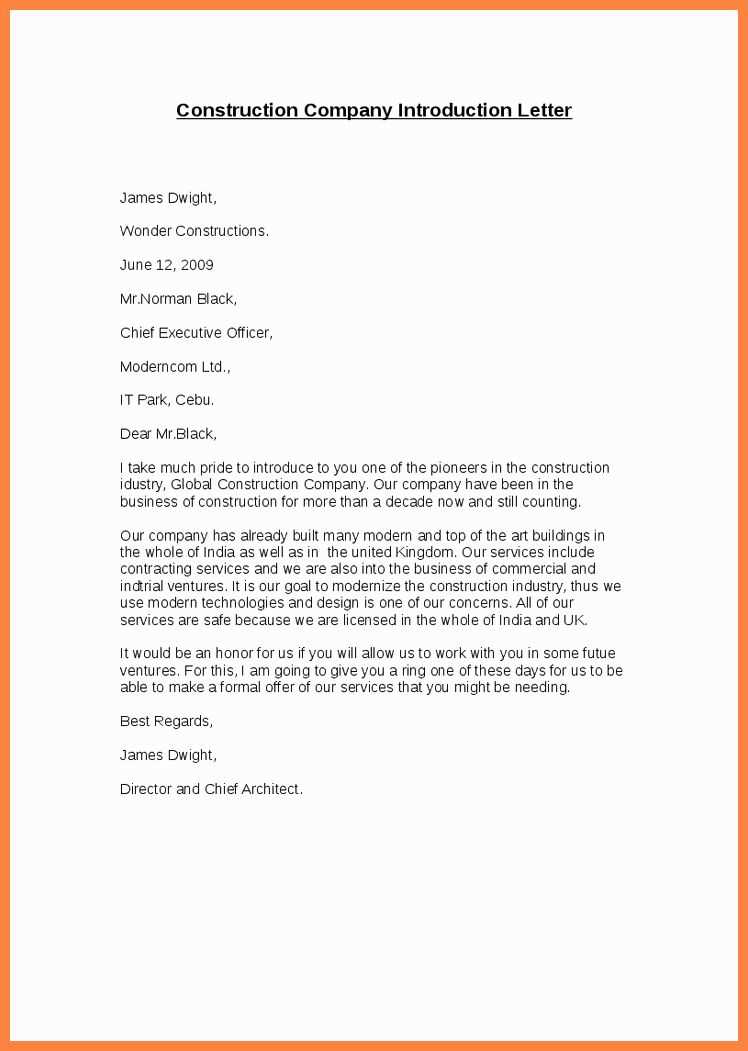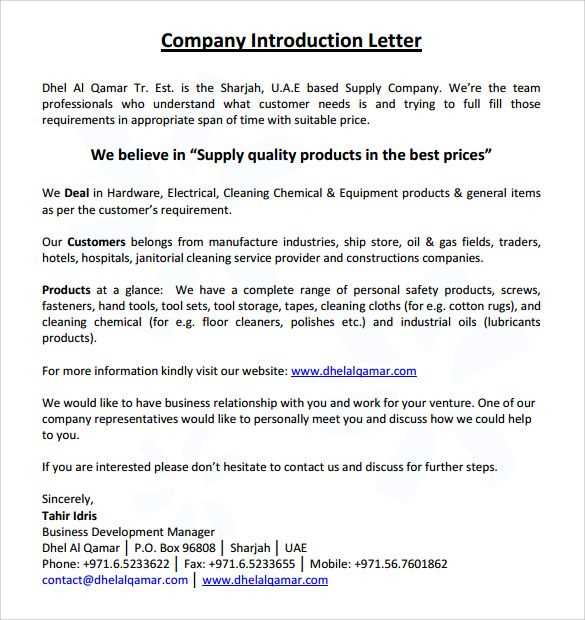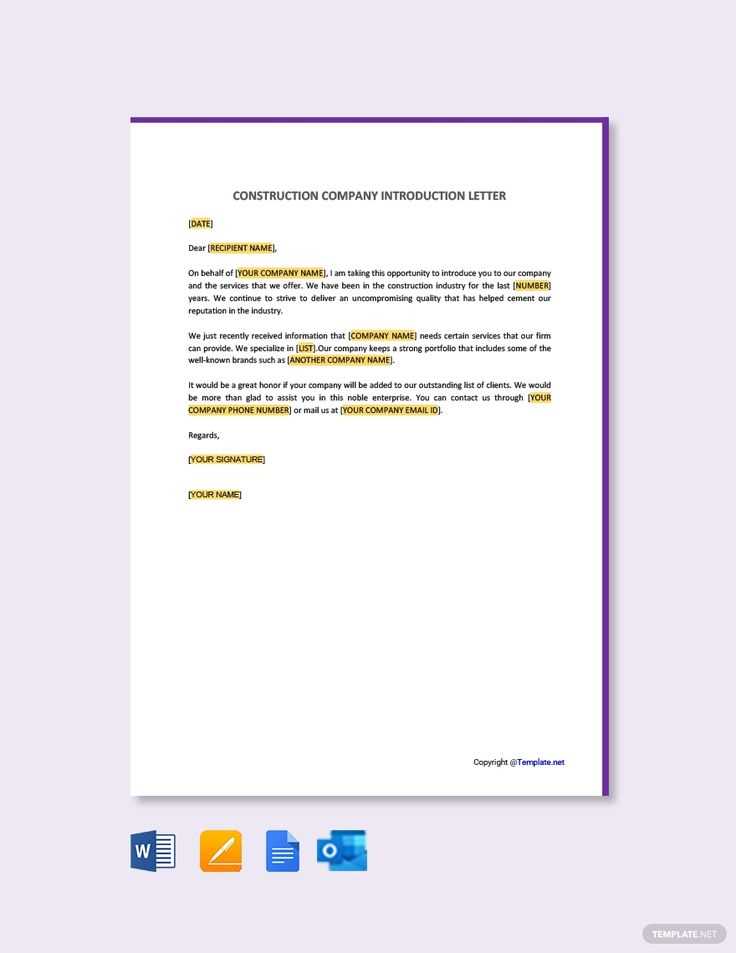Company introduction letter template

To create an impactful company introduction letter, focus on clearly stating your company’s values, mission, and what sets you apart from others. Begin by introducing your company with a direct and engaging opening line that addresses your recipient’s potential interests or needs. Highlight the most significant aspects of your services or products right away, making it clear how you can provide value.
Be concise and ensure that your tone is professional yet approachable. The letter should provide enough detail for the reader to understand your company’s objectives, without overwhelming them. A simple structure works best: start with a brief introduction, follow with key points about what your company offers, and close with a call to action or invitation for further communication.
Always remember to personalize the letter where possible. Tailor it to the recipient to make it more relevant and demonstrate that you understand their specific business needs. A direct invitation to meet or discuss can make your letter feel less like a generic introduction and more like the start of a valuable business relationship.
Choosing the Right Tone for Your Letter

The tone of your company introduction letter directly impacts how your message is received. Opt for a tone that matches the context and audience. If you’re introducing your company to potential clients, aim for a professional yet approachable tone. Avoid being too formal or too casual, as this can create barriers or seem insincere.
Be clear and direct. Convey your message without ambiguity. Avoid using overly complex sentences or jargon that may confuse the reader. Your goal is to make the reader feel confident in what you offer without unnecessary distractions.
Personalize your approach. If possible, address the recipient by name and tailor the letter to their specific needs or interests. This adds warmth to your communication and shows that you’ve taken the time to understand them.
Balance professionalism with friendliness. While your letter should maintain a formal structure, it’s important to appear welcoming. A tone that is both confident and respectful creates a positive first impression, which encourages further engagement.
Keep the language simple. Avoid fluff and filler words. Use clear, concise language that gets straight to the point. Readers will appreciate a letter that respects their time and communicates effectively.
Adjusting the tone to suit the context ensures your letter achieves its purpose, whether it’s to build trust or create curiosity. By understanding the recipient’s expectations, you can craft a message that resonates and invites action.
Structuring Your Letter for Maximum Clarity
Begin with a clear, concise subject line that sets the tone and purpose of the letter. Ensure it reflects the content and intent of the message, making it easy for the recipient to identify the main topic immediately.
Open with a direct greeting, using the recipient’s name whenever possible. This creates a personal connection and shows attention to detail. Keep the introduction brief and immediately follow up with the reason for writing. Avoid unnecessary pleasantries that don’t add to the clarity of the message.
Use short paragraphs for each key point you wish to convey. This improves readability and ensures the letter doesn’t overwhelm the reader with dense blocks of text. Group related ideas together, and avoid shifting topics within a single paragraph.
Be direct and specific in your wording. State your intentions, requests, or key information clearly without digression. Focus on the outcome you are aiming for and how the recipient can help or respond.
Maintain logical flow. Each paragraph should naturally lead to the next, guiding the reader through the letter without confusion. Use transitional phrases like “Additionally” or “For example” when connecting points to keep the flow smooth.
Close with a clear call to action or a summary of next steps. Be specific about what you need from the recipient and how they should respond. End with a polite closing that matches the tone of the letter and reflects the relationship you have with the recipient.
Customizing the Template for Different Audiences

Tailor the company introduction letter based on the recipient’s role, interests, and expectations. The tone and content should match their specific needs for the most impact.
For potential clients or customers, focus on how your company can meet their needs. Highlight your products or services and explain how they provide solutions. Use a formal, clear, and concise tone to establish credibility.
For potential partners or collaborators, emphasize your company’s values, vision, and mutual benefits of collaboration. This audience values long-term relationships and synergy. A slightly informal and approachable tone may be more effective here.
When addressing investors, emphasize your company’s performance, growth opportunities, and financial stability. Focus on key metrics and future projections. Keep the language professional and data-driven.
For internal teams, focus on company culture, internal updates, or team achievements. Make the letter more conversational and engaging to encourage employee buy-in and motivation.
| Audience | Key Focus | Tone |
|---|---|---|
| Potential Clients | Products/Services, Solutions | Formal, Clear, Concise |
| Potential Partners | Collaboration, Synergy, Values | Slightly Informal, Approachable |
| Investors | Growth, Financial Stability | Professional, Data-driven |
| Internal Teams | Culture, Internal Updates | Conversational, Engaging |
Adjusting your language, tone, and focus according to the audience will ensure your message resonates and fosters a connection with the reader.
Common Mistakes to Avoid When Writing Your Letter

Keep the tone professional but approachable. Avoid sounding too casual or overly formal. Find the right balance that reflects your company’s identity and fits the purpose of the letter.
Be specific and clear about your intentions. Don’t leave your reader guessing what your company offers or what you expect from them. Provide concrete details and examples that highlight your strengths.
- Overusing jargon or technical terms: Use simple, clear language. Avoid complicated terms that could confuse your reader.
- Neglecting proofreading: A letter with spelling or grammatical errors reflects poorly on your company. Take time to review and revise your message.
- Writing an overly long letter: Respect your reader’s time. Keep the content concise and to the point.
- Ignoring the reader’s needs: Tailor the content to the specific audience. Make sure the letter addresses what matters most to them.
- Being too vague: Generalities don’t make a strong impression. Provide clear information on what makes your company unique.
Stay focused on the main message. Avoid unnecessary details that distract from the purpose of your letter. Don’t overwhelm your reader with information.
Always include a clear call to action. Don’t leave your reader wondering what to do next. Tell them how they can get in touch or what step to take.